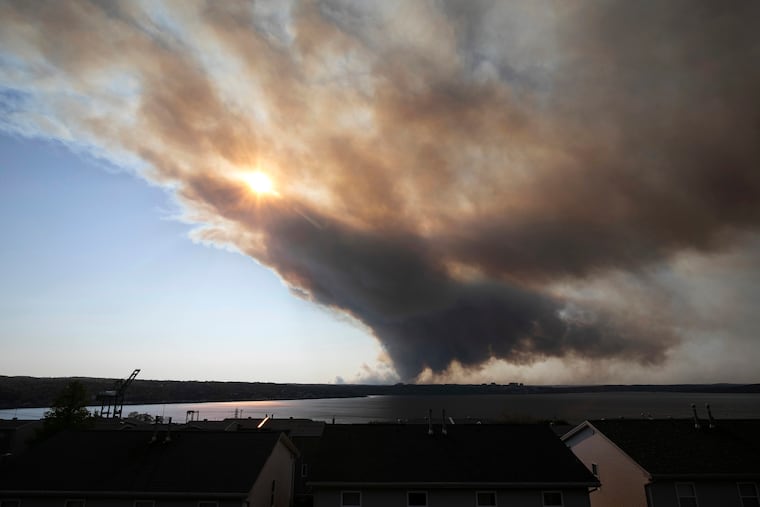That wildfire smoke in the air over Philly this week may be unprecedented
The entire region and all of New Jersey was under a "code orange" air quality alert Wednesday.

Philadelphians and other residents of the Northeast Corridor have witnessed their share of wildfire smoke recently, but this week they may be seeing something rare, if not unprecedented.
Wildfires in Nova Scotia — a province famed for its lobster and stunning coastal beauty — on average consume about 1,200 acres annually, said Brett Anderson, a smoke-forecast specialist with AccuWeather Inc. This recent outbreak has consumed more than 50,000, a record that has resulted in thousands of evacuations.
What has burned this year exceeds the aggregate total of all the charred acreage in the province between 2006 and 2022, he said.
» READ MORE: Last week's smoke was from a far different Canadian source
With plumes of smoke streaming southwestward on onshore winds, Philadelphia was under a “code orange” air quality alert Wednesday, with the NOAA forecast calling for more smoke to appear again in a corridor from Boston to central Virginia into Thursday.
Under code orange, officials advise the elderly, the very young, and those with respiratory conditions to limit outdoor activity.
This is the time of year when the winds get ever lazier, and what comes around doesn’t always go away.
“We’re in a fairly persistent pattern,” said Paul Fitzsimmons, a meteorologist at the National Weather Service Office in Mount Holly, adding that the smoke concentrations would vary with “little subtleties” in the flow.
The smoke shouldn’t present hazards to the healthy — although allergy sufferers may have unrelated issues, as generous supplies of pollen also might be in the air the next few days.
A smoky difference
This smoky invasion differs from that of last week in that the source is only about 1,000 miles away due northeast, as opposed to about 3,000 miles to the northwest.
The Nova Scotia smoke is riding nearer-surface winds, under 10,000 feet, from the east and northeast, said Fitzsimmons.
The western smoke rode jet-stream winds about 25,000 miles in the atmosphere, and little if any of that mixed down to where people live around here.
As to why the woods in Nova Scotia have flared the way they have, they were primed by a dry spring and warm weather, said Anderson.
He added the dry spell has gone against the trend of a generally wetter period in the region associated with the warming of the oceans related to climate change.
The forecast
Those onshore winds are forecast to continue until at least late in the day Thursday, but Anderson said he would not expect the smoke to be as robust around here, and the air quality is forecast to improve to the “moderate” stage.
Unfortunately for allergy sufferers, those winds also likely will be transporting considerable amounts of pollen. Conditions may be ideal for pollen flight the rest of the workweek, during the one time of the year when both the grasses and trees are emitting their reproductive tormentors in concert.
» READ MORE: Wildfire smoke was a serious source of pollution two summers ago
The air will be quite dry, with temperatures heading in the July-like mid- to upper-80s. They might crest past 90 degrees Friday.
In the Asthma Center’s daily count, tree pollen was “high” Wednesday, and grass was “moderate.”